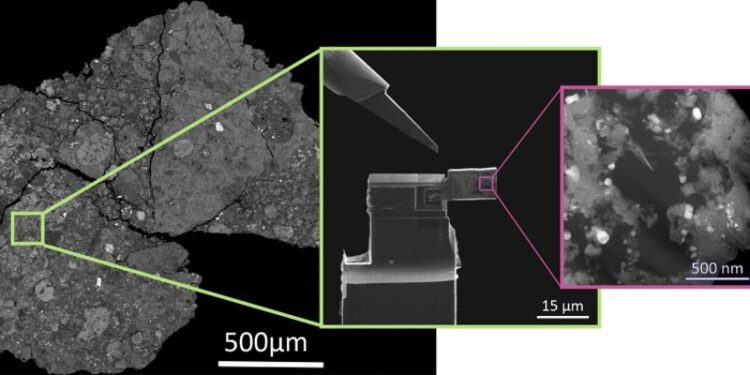Cosmic building blocks of life discovered through the electron microscope

Using a nanomanipulator and an ultra-fine ion beam, a tiny lamella, about five by ten micrometres in size and only one hundred nanometres thin, is cut out of the meteorite and attached to a sample bar. The scientists can then analyze the organic particles in this lamella under an electron microscope (right).
© SuperSTEM Laboratory, Daresbury, UK
For the first time without any chemical treatment, a research team analyses extraterrestrial amino acids and other organic compounds in an English meteorite fall.
Meteorites are fragments of asteroids which find their way to Earth as shooting stars and provide information on the origins of our solar system. A team of researchers has examined the so-called Winchcombe meteorite and demonstrated the existence in it of nitrogen compounds such as amino acids and heterocyclic hydrocarbons – without applying any chemical treatment and by using a new type of detector design.
Meteorites are fragments of asteroids which find their way to Earth as shooting stars. These cosmic sediments have frozen the primordial soup from which our solar system emerged – preserving it just like a time capsule. These rocks help researchers to get to the bottom of the origins of matter and of life on Earth. Working together with British colleagues, Dr. Christian Vollmer from the Institute of Mineralogy at Münster University has examined one of these time capsules, and a very special one – the Winchcombe meteorite. The team of researchers are now the first to demonstrate, to a high degree of precision, the existence of some important nitrogen compounds in this meteorite with amino acids and heterocyclic hydrocarbons – without applying any chemical treatment, and by using a new type of detector design. The results have been published in the journal “Nature Communications”.
Background
The Winchcombe meteorite was observed by a camera network in England in February 2021, and it was collected within just a few days. “Normally, meteorites are tracked down in the cold and hot deserts on Earth, where the dry climate means that they don’t weather very fast, but they do change as a result of humidity,” says Christian Vollmer. “If a meteorite fall is observed soon after the event and the meteorite is quickly collected, as was the case in Winchcombe, they are important ‘witnesses’ for us regarding the birth of our solar system – which makes them especially interesting for research purposes.”
The origins of life on our planet are still shrouded in mystery, and some researchers assume that the first biologically relevant matter was transported to Earth in meteorites over four billion years ago. This matter includes for example complex organic compounds such as amino acids or hydrocarbons. However, these molecules have only very low concentrations, and the experts generally have to separate them out from the meteorite by using solvents or acids and then enrich them for analytical purposes. Christian Vollmer’s team was now the first to be able to demonstrate the existence of these biologically relevant nitrogen compounds in the Winchcombe meteorite without first treating them chemically – although here too the concentrations of these substances are very low. In their work, the researchers used a modern, high-resolution electron microscope such as is found at only a few locations worldwide. This “super-microscope” at the SuperSTEM laboratory in Daresbury in England not only depicts high-carbon compounds at atomic resolution – it can also analyse the samples chemically by means of a new type of detector. “Demonstrating the existence of these biologically relevant organic compounds in an untreated meteorite is a significant achievement for research,” says Vollmer. “It shows that these building blocks of life can be characterised in these cosmic sediments even without chemical extraction.” The development is also of great importance because chemical treatment includes the risk of these fragile substances being changed. This is why the analytical methods applied here to solid matter are potentially also valuable for research on small, extraterrestrial specimens brought back to Earth from space missions – such as the dust particles from asteroids recently brought back by the Japanese Space Agency (Hayabusa2) and NASA (OSIRIS-REx).
The work received financial support from the German Research Foundation as part of the Priority Programme SPP1833 “Building a habitable Earth”.
Wissenschaftliche Ansprechpartner:
Dr. Christian Vollmer
Institut für Mineralogie
University of Münster
E-Mail: christian.vollmer@uni-muenster.de
Phone: +49 251 8333461
Originalpublikation:
https://doi.org/10.1038/s41467-024-45064-x
https://www.uni-muenster.de/news/view.php?cmdid=13836&lang=en
Media Contact
All latest news from the category: Earth Sciences
Earth Sciences (also referred to as Geosciences), which deals with basic issues surrounding our planet, plays a vital role in the area of energy and raw materials supply.
Earth Sciences comprises subjects such as geology, geography, geological informatics, paleontology, mineralogy, petrography, crystallography, geophysics, geodesy, glaciology, cartography, photogrammetry, meteorology and seismology, early-warning systems, earthquake research and polar research.
Newest articles

Innovative 3D printed scaffolds offer new hope for bone healing
Researchers at the Institute for Bioengineering of Catalonia have developed novel 3D printed PLA-CaP scaffolds that promote blood vessel formation, ensuring better healing and regeneration of bone tissue. Bone is…

The surprising role of gut infection in Alzheimer’s disease
ASU- and Banner Alzheimer’s Institute-led study implicates link between a common virus and the disease, which travels from the gut to the brain and may be a target for antiviral…

Molecular gardening: New enzymes discovered for protein modification pruning
How deubiquitinases USP53 and USP54 cleave long polyubiquitin chains and how the former is linked to liver disease in children. Deubiquitinases (DUBs) are enzymes used by cells to trim protein…



